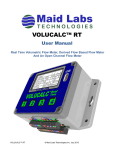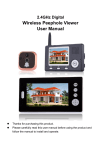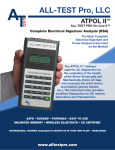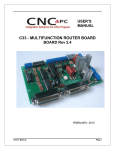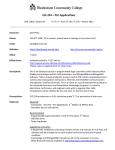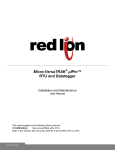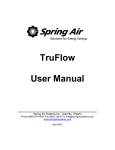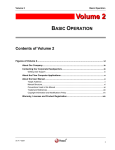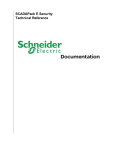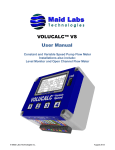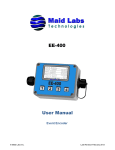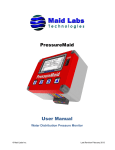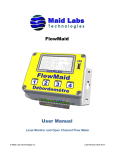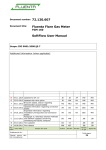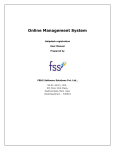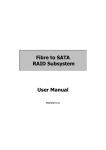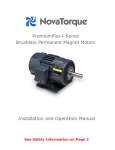Download engineering specifications
Transcript
Maid Labs Technologies Inc. Volucalc RT Specifications Item RTU Description 1.01 The RTU shall be a Volucalc RT or approved equivalent. 1.02 The RTU shall have a built in battery charger able to charge and keep the external replaceable sealed battery charged. 1.03 The RTU shall have a battery backup system capable of keeping the RTU, the communication hardware and the level sensor powered for 48 hours in case of primary AC failure. A different user selectable communication pattern can be set for battery operation. 1.04 The RTU shall be set to transmit immediately when abnormal conditions occur and at specific interval under normal conditions. 1.05 To record pump current, the RTU shall allow to set the pump inputs CTs for 15 Amps, 75 Amps, 300 Amps or for other custom values to be approved by RTU manufacturer. 1.06 A 12 VDC output shall be used to power the communication hardware and level sensor and switch automatically between AC power and battery power in the event of a power failure. 1.07 A pump specific relay output shall be activated when an abnormal condition is related to a pump, unless specified otherwise by the user 1.08 All abnormal conditions shall be displayed on the screen of the instrument and shall be acknowledge by the user to have access to the regular menu, unless specified otherwise. 1.09 A high variation in pump capacity shall generate an abnormal condition based on user specification. 1.10 A high variation in inflow shall generate an abnormal condition based on user specification. 1.11 Higher than usual current draw shall generate an abnormal condition based on user specification. 1.12 Lower than usual current draw shall generate an abnormal condition based on user specification. 1.13 An abnormal sequence of operation of the pumps shall generate an abnormal condition. 1.14 Extremely long run time, based on average pump cycle time, shall generate an abnormal condition. 1.15 Extremely short run time shall generate an abnormal condition. 1.16 An abnormal condition shall be generated when the level is falling and no pumps are in operation. 1.17 An abnormal condition shall be generated when the level have not changed for a long period. 1.18 The RTU shall be able calculate volumetric flow in real time within 2%, when a calibrated analog level sensor is connected to the RTU, constant speed pumps are used and proper calibration is done. 1.19 The RTU shall be able calculate a derived flow by integrating variable speed pump curves based on the pumps RPM supplied by the analog output of the VFDs. The accuracy is related to the precision of the pump curves entered in the configuration software and the Specifications can change without notice quality of the calibration done at the site. The optional availability of an analog level input and a force main pressure input increase the accuracy. 1.20 The RTU shall be able calculate a derived flow using constant speed pump curves or preset capacities. The accuracy is related to the precision of the pump curves or capacities entered in the configuration and the quality of the calibration done at the site. The optional availability of an analog level input and a force main pressure input increase the accuracy. 1.21 The RTU shall be able to use the flow from an external flow meter, like a mag meter, a clamp on flow meter or an open channel flow meter. 1.22 The RTU shall be able to calculate flow using standard open channel flow formulas. 1.23 The RTU shall be able to integrate all of the above flow formulas and display the resulting value on screen. 1.24 The RTU shall have a 4 to 20 mA configurable analog output that can be set proportional to the flow calculated. 1.25 An abnormal condition shall be generated in the event of a change in analog value of more than a user specific value. 1.26 Any change of the RTU digital input shall be transmitted to the central monitoring software immediately when the internet connection is available and ready. 1.27 The RTU shall have one (1) digital input that can be used as pulse counting totalizers, like for rain monitoring. 1.28 The RTU shall have 4 pump current inputs recording pump current and change of state in one (1) second resolution. 1.29 Unused pump inputs can be set to record analog values. User can select between 420mA, 0-5vdc, 0-10vdc and 0-24vdc for each of the pump inputs. 1.30 Installation brackets shall be available to install the RTU on an internal panel door, on a DIN rail, being bolted and in a NEMA 4X enclosure. 1.31 Transmit all data and alarms via any internet connection including wired, Wi-Fi, cellular (all technologies), radio or satellite. 1.32 Be powered by 12 to 24 volts DC. 1.33 Be supplied with a U.L., ULC or CSA recognized 120 VAC to 12-24VDC 2A power supply . 1.34 Have built in AC failure and low battery detection. 1.35 The RTU shall have 6 analog inputs, 10-bit resolution, selectable between 4-20mA, 0-5 vdc, 0-10 vdc and 0-24 vdc, with a maximum cumulative of 64 alarm settings. 1.36 If an analog level sensor is used to control the pumps, the RTUs shall record the average levels of operation of the pumps. If a level higher than the lag pump is reached and no pumps are in operation, then the RTU shall generate an alarm. 1.37 The RTU shall have two (2) additional relays. One can be used to supply power to the modem and level sensor during power failure. The other can be used in backup controller mode and can be remotely controlled. 1.38 The RTU shall be able to need a user password to have access to the device’s configuration, data and USB download functions. 1.39 All data shall be recorded on flash memory with a minimum capacity of 2 Gb. The memory shall not be affected by power loss from AC or battery, internal or external. Specifications can change without notice 1.40 Settings related to display, language, units, communication, open channel parameters and analog level adjustments shall be configured with the RTUs keyboard when necessary. 1.41 The keyboard keys shall be context sensitive. 1.42 The display shall present the following type of information: Real time flow – Pump, flow and rain statistics – Power consumption – Configuration – I/O and communication tests – On screen reports – Alarms – USB transfer including settings, data and firmware upgrades. 1.43 The default screen shall display level (with analog level sensor), when the next pump operation should occur, flow in and out, the state of all the relays and communication, date and time. 1.44 The Real Time screen shall display the level, the force main pressure, the head, the flow rate and the current used by each pump in operation 1.45 The Pump Statistics screen shall display for each pump and each combination of pumps the number of starts, run time, average flow rate, total volume that went through the displayed pump(s) and the actual flow rate. 1.46 The Power Consumption screen shall display the electrical consumption in kWh and $. 1.47 The Internal Information screens shall display the voltage powering the RTU, the voltage of the external battery used for power backup, the battery charging status, the status of the digital input, the value of the analog input used for pressure monitoring, the value of the level input and the internal temperature of the RTU. 1.48 The Rain Statistics screen shall display total rain, last month rain, today’s rain and rain maximum intensity. A Reset button shall be available. 1.49 If an analog level sensor is used for SSO monitoring, the Analog Sewage Sewer Overflow screen shall display the flow rate of the liquid lost, its minimum and maximum flow rate, total volume lost and number of events. 1.50 If a digital level sensor is used (like a float) for SSO monitoring, the Digital Sewage Sewer Overflow screen shall display the duration of the last SSO event, when was the last event and the number of events. 1.51 The Configuration screen shall allow the user to change the parameters related to: date, time, units, display settings, I/O, level setup, open channel flow setup, communication, alarms, reset cumulative and firmware upgrade. 1.52 An HTML formatted reports shall be generated for each month with the following information: Stations settings, pump statistics (run time, volume, power consumption and electrical cost). For each day, it should have the power consumption, the energy wasted, the greenhouse gas generated because of the energy wasted, the percentage of use of the station, the maximum level reached, rain, total volume, average flow, minimum flow rate and time of occurrence, maximum flow rate and time of occurrence, average outflow of the pumps and totals or averages for all. For each pump and combination of pumps and for each day: Number of starts, total run time, run time alone, average current, volume, efficiency in Volume/kWh, average capacity of the day and totals and averages for all. For each alarm, it should have the name of the alarm, the beginning and ending time, duration, the reason (like level reached) and description. 1.53 The USB screen shall allow to copy to the USB drive Digital events reports, Monthly flow reports, Monthly Volucalc reports, the Volucalc RT User Manual, MerMaid software compatible format data, Configuration, RAW and Technician data (for technical support). Specifications can change without notice The USB screen shall allow copying configuration files and firmware updates from the USB drive. 1.54 A Test screen shall allow testing of the analog output of the RTU. 1.55 When communication is available with Maid Maps web server, the RTU shall be able to receive firmware upgrades and new settings. 1.56 The antenna and mounting hardware shall be selected based on site’s requirements and communication device used. 1.57 The RTU shall have the TCP/IP MODBUS protocol and supply registry access to volumes, flow, capacities, efficiencies, starts, run times and all alarms, which all can be reported in real time or totalized since last access. 1.58 The RTU shall be able of reporting alarms and all supervisory information to a password protected server web site supplied free of charge by Maid Labs Technologies Inc. 1.59 A free configuration software shall be supplied with the RTU. 1.60 Be designed for ease of installation. Specifications can change without notice




